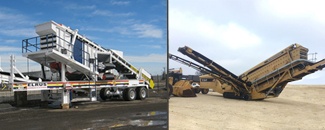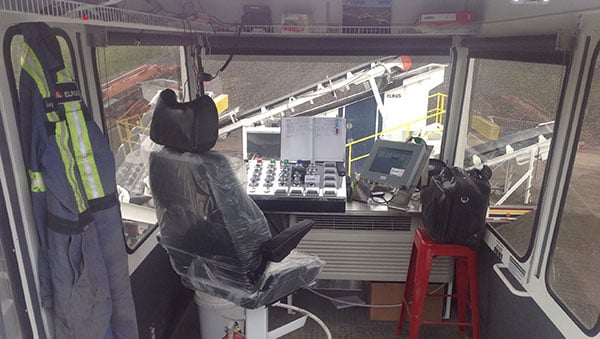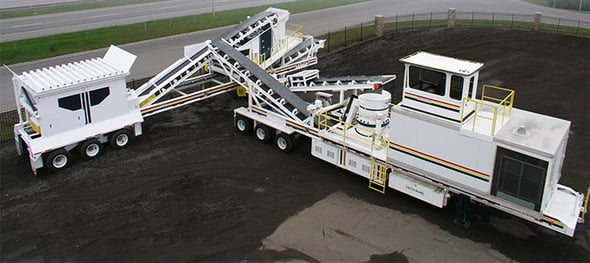 Having the right crushing and screening equipment to handle your environment, materials, and end products is critical. The wrong equipment will cost you a lot of money and time so understanding the relative advantages and disadvantages of equipment is key to making the best decision for your business.
Having the right crushing and screening equipment to handle your environment, materials, and end products is critical. The wrong equipment will cost you a lot of money and time so understanding the relative advantages and disadvantages of equipment is key to making the best decision for your business.
Which is right for you?
Cost of Ownership and Operation
Consider the various cost factors associated with the two types of equipment.
Purchase Cost & Life Cycle Cost: For the initial purchase, both tracked and portable spreads of comparable quality will be about the same capital purchase, between $1.5 to $2.0 million.
Well maintained portable plants (excluding the generator, bearings, normal wear components) can last 20,000 hours in difficult applications and 30,000 hours in easier applications before requiring a major overhaul which can significantly extend the usable life of the machine.
Tracked plants generally have little usable life past 12,000 hours as the diesel engine, hydraulics, undercarriages, and electrical sensors reach their end of life or become unreliable. Usable life can be as little as 8,000 hours in difficult applications.
While up front purchase price is similar, there are major differences in capacity and lifespan for your investment, production flexibility and operating costs.
Depreciation Costs of Production: For comparison purposes assume both spreads had a $1.75 MM purchase price, Depreciation costs could look like this:
| Track Mounted | ||
| Purchase Price | Hours | Est. Depreciation per Hour |
| $1,750,000 | 8,000 (Hard & Abrasive Cond. | $218.75 |
| $1,750,000 | 12,000 (Soft and less abrasive conditions) | $145.83 |
| Portable | ||
| Purchase Price | Hours | Est. Depreciation per Hour |
| $1,750,000 | 20,000 (Hard & Abrasive Conditions) |
$87.50 |
| $1,750,000 | 30,000 (Soft and less abrasive conditions) |
$58.33 |
Depreciation costs are doubled or worse with track mounted equipment!
As startling as this analysis is, it is still simplistic as the resale value is not considered. What can you expect on re-sale or trade-in?
Portable equipment holds more of its value and can have considerable productive life left at 20,000 hours use. A review of auction sale results yields considerable insights into how this differential works and a good investment of time.
Financing Implications: Due to the rapid depreciation and shorter lifespan of tracked equipment may result in a negative equity position for the usable life of the equipment.
Production Capacity: Many manufacturers of tracked equipment make their Jaws, Cones, Impactors and Screens available for use in Portable and Stationary applications. Often these manufacturers rate the production capacity higher when these machines are run on electricity as performance characteristics for components are different when operated hydraulically. This is more noticeable in hard rock applications and also when operating in high ambient air temperatures as the viscosity of hydraulic fluid thins while electric motors provide 100% of their torque at any operating RPM.
Fuel and Operating Costs: Each tracked plant has its own diesel power, therefore a spread of tracked equipment will have 3 to 5 diesel engines to operate, maintain and service. Daily refueling and starting/stopping of multiple engines all complicate daily operations.
Well designed, portable spreads are powered by electricity generated from a single diesel engine. Fuel consumption is less than multiple tracked plants and, importantly, there are fewer engines to operate and maintain. With the tracked spread, you perform 3-5 oil changes every 250 hours; with the portable spread, you perform one, so is easier to schedule and you only need to stock one kind of filter.
Safety
The operator of a portable spread can sit in a dust free, climate controlled tower with 360 degrees of visibility and one button complete shutdown vs. running to each machine to shut off.
While new tracked equipment can be configured to be operated from the loader as long as it is from the same manufacturer, portable equipment can be connected to the same control system regardless of manufacturer and/or age.

Set up and Transportation
Tracked plants are popular because of short set up time. This is attractive for small scale or short term production adjustments requiring as single plant. This advantage does not hold for a spread of multiple plants in a high production environment however.
Well designed, portable equipment, besides being highly efficient, shrinks set up times. Full spreads should require a day or less, eliminating the set-up time advantage tracked has over traditional portable equipment with multiples of loose conveyors.
Potential for higher costs of moving a tracked plant to a new location or to a shop for repairs need to be considered. Portable equipment requires only a highway tractor to move as it is an independent chassis; tracked equipment is heavier and longer, and requires a float trailer.
Productivity
Crusher Size: Productivity is higher with portable equipment because there is less down time due to maintenance and repairs. Additionally, portable equipment can produce higher volumes as the crushers and screens can be larger. For example, portable Screen Plants as large as 8 x 20 and cone crushers as large as 500 Horsepower are readily available.
Working the Face: Tracked equipment can be easily repositioned to get closer to the face. Consider that it is the loader or excavator that works the face, not the crusher. Portable equipment can generally be fed with much larger loaders, negating this advantage.
Closing a Circuit: Tracked equipment is difficult to marry up and close a circuit for producing tighter specifications. Most tracked spreads work best in a straight line and to close a circuit, you may have to use loose conveyors or “reprocess by closing the circuit with a loader.” If you have a well-designed portable spread, you can close the circuit without loose conveyors by simply backing up the cone plant to the side of the screen plant. Additionally, you should not have to dig a hole or build a pad to have each plant feed the next plant.
Environment
Each piece of tracked equipment has its own fuel tank, hydraulic tanks and hydraulic hoses. Portable equipment has one fuel tank for the generator and only small hydraulic tanks to operate the jacking and leveling systems.
Spill risk is made higher on tracked equipment by the number of fueling events required and the sheer volume of hydraulic fluid and hoses.
Maintenance
Well maintained equipment will last longer than poorly maintained equipment. Consider the overall costs and ease of maintenance when considering the two spread types.
Maintenance costs for tracked equipment are likely to be higher over time vs. portable equipment. Multiple diesel engines, solenoids, hydraulic motors, hoses, valves and sensors increase the probability of downtime. Murphy’s law applies - with mechanical complexity if it can go wrong it will. Further complicating maintenance on tracked equipment is the recent proliferation of electronic sensors that will shut down entire systems when they fail due to vibration or dirt. And, experience shows these sensors are rarely located in the most maintenance friendly locations.
Because of this complexity, a diesel hydraulic specialist from the dealership at $120-175 per hour is often required to diagnose and address these problems. The volume of spare parts sales also makes tracked equipment very attractive to the manufacturer and dealerships.
Portable equipment is all electrical and therefore requires less maintenance and has a far longer lifetime than the diesel/hydraulic combination.
The undercarriage on tracked equipment is another risk area as there are far more things to be maintained and repaired vs. tires and rims.
Footprint
The footprints of each spread may factor in what is right for your application:
Tracked spreads may be a good choice where space limitations dictate how equipment can be set-up. Examples include:
- Recycling applications where material is processed on a demolition site and re-used on site
- Applications where a single processing unit is adequate. A single tracked plant will take up less space than a portable spread.
- Tight roadside conditions may dictate end-to-end configuration for the processing of material.

Tracked equipment is also often used to open an initial mine site due to its small footprint where it can be placed near the excavator.
Rentals
When a single piece of equipment is needed to supplement an existing operation rental is an easy solution. When you have a small demolition or processing job, renting tracked equipment makes sense. Other applications should be carefully analyzed.
The rental market is dominated by tracked equipment. It is a simpler business model for the dealer as units are self-contained and dealers also find the higher parts and service sales volume attractive.
Most rental contracts for either tracked or portable have purchase options. If you have a larger job with months of rent into a machine, it often feels compelling to buy it out vs. “losing the equity” in your rental spend. While it makes sense to exercise purchase options in some cases - exercising this option on a machine that depreciates at double or triple the rate of the alternative rarely makes financial sense. For this reason, long term rentals on tracked equipment rarely make sense, despite reasonable rental rates.
If you need equipment for larger production jobs, renting is probably not economical and renting tracked is certainly not.
Why Buy Portable Equipment
- If you are investing in crushing equipment for the long term, your cost of ownership and operation will be less with portable.
- If you have a variety of products to crush that requires flexibility in process configurations.
- If you need to produce larger tonnages in fixed time periods for contracts or seasonal requirements and need to operate on a multi shift or even 24/7 operations.
- If you need the flexibility of tracked and the production rates that have been traditionally available with stationary crushing “factories” wheeled portable is the answer for your business.
Click the blue button below to learn more about the ELRUS portable soution.


